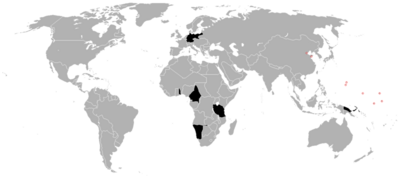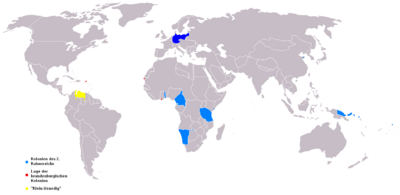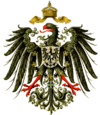German colonial empire
The German colonial empire was an overseas area formed in the late 19th century as part of the Hohenzollern dynasty's German Empire. Short-lived colonial efforts by individual German states had occurred in preceding centuries, but Imperial Germany's colonial efforts began in 1883. The German colonial empire ended with the Treaty of Versailles in 1919 following World War I.
German Empire
Owing to its delayed unification by land-oriented Prussia in 1871, Germany came late to the imperialist scramble for remote colonial territory — their so-called "place in the sun". The German states prior to 1870 had retained separate political structures and goals, and German foreign policy up to and including the age of Otto von Bismarck concentrated on resolving the "German question" in Europe and securing German interests on that same continent. On the other hand, Germans had traditions of foreign sea-borne trade dating back to the Hanseatic League; a tradition existed of German emigration (eastward in the direction of Russia and Romania and westward to North America); and North German merchants and missionaries showed lively interest in overseas lands. The rise of German imperialism also coincided with the "scramble for Africa," during which Germany competed with other European powers for control of the last unexplored continent's territory.
Many Germans in the late 19th century viewed colonial acquisitions as a true indication of having achieved nationhood, and the demand for prestigious colonies went hand-in-hand with dreams of a High Seas Fleet, which would become reality and be perceived as a threat by the United Kingdom.
Because Germany was so late to join the race for colonial territories, most of the world had already been carved up by the other European powers; in some regions the trend was already towards decolonisation, especially in the continental Americas, encouraged by the American Revolution, French Revolution, and Napoleon Bonaparte.
When the Herero people of German South-West Africa (now Namibia) rose in rebellion in 1904, they were defeated by German troops; tens of thousands of natives died during the resulting genocide.
The victorious Allied Powers dissolved and re-assigned this empire in the course of the First World War (1914-1918) and its subsequent peace treaties, such as the Treaty of Versailles.
In the treaties Japan gained the Carolines and Marianas, France gained Cameroons, Belgium gained small parts of German East Africa, and the United Kingdom gained the remainder, as well as German New Guinea, Namibia, and Samoa. Togoland was divided between France and Britain. Most of these territories acquired by the British were attached to its various Commonwealth realms overseas and were transferred to them upon their independence. Namibia was granted to South Africa as a League of Nations mandate. Western Samoa was run as a class C League of Nations mandate by New Zealand and Rabaul along the same lines by Australia. This placing of responsibility on white-settler dominions was at the time perceived to be the cheapest option for the British government, although it did have the bizarre result of British colonies having their own colonies. This outcome was very much influenced by W.M. Hughes, the Australian Prime Minister, who was astounded to find that the big four planned to give German New Guinea to Japan. Hughes insisted that New Guinea would stay in Australian hands, with the troops there defending it by force if necessary. Hughes achievement in preventing Japan occupying New Guinea was of vital importance in World War 2.
William II, German Emperor, was so frustrated by the defeat of his European generals that he declared[citation needed] that Paul von Lettow-Vorbeck, the German general in charge in East Africa, should be the only German officer allowed to lead his soldiers in a victory parade through the Brandenburg Gate. Vorbeck was the only undefeated German general of the war, and the only one to set foot in British territory. //www.deutsche-schutzgebiete.de/menueleiste.htm&url=http://www.deutsche-kaiserreich.de/ German colonies ]
This is a list of former German Empire colonies and protectorates (German: Schutzgebiete), the German colonial empire.
Welser colonies
America
- Little Venice (Klein Venedig) (see German colonization of the Americas)
Brandenburger-Prussian colonies
Africa
- Groß Friedrichsburg (in Ghana), 1683–1718
- Arguin (in Mauretania), 1685–1721
- Whydah, in present Togo ca 1700 (this Brandenburg 'colony' was just a minor point of support, a few dwellings at a site where British and Dutch had theirs too)
America
- Saint Thomas (Caribbean, now in the United States Virgin Islands), brandenburg Lease territory in the Danish West Indies; 1685–1720)
- Island of Crabs/Krabbeninsel (Caribbean, now in USA), brandenburgische Annexion in the Danish West Indies; 1689–1693 )
- Tertholen (Caribbean sea; 1696)
German imperial colonies
Africa
- German East Africa - (Deutsch-Ostafrika)
- Tanganyika; after World War I a British League of Nations mandate, which in 1962 became independent and in 1964 joined with former British protectorate of the sultanate of Zanzibar to form present-day Tanzania
- Ruanda-Urundi: 1885 – 1917
- Wituland 1885 – 1890, since in Kenya
- Kionga Triangle, since 1920 (earlier occupied) in Portuguese Mozambique
- German South West Africa - (Deutsch-Südwestafrika)
- Namibia (present-day) except then-British Walvis Bay (Walvisbaai)
- Botswana - (Südrand des Caprivi-Zipfels)
- German West Africa (Deutsch-Westafrika) - existed as one unit only for two or three years, then split into two colonies due to distances:
- Kamerun 1884 – 1914 ; after World War I separated in a British part, Cameroons, and a French Cameroun, which became present Cameroon. The British part was later split in half, with one part joining Nigeria and the other Cameroon. (Kamerun, Nigeria-Ostteil, Tschad-Südwestteil, Zentralafrikanische Republik-Westteil, Republik Kongo-Nordostteil, Gabun-Nordteil)
- Togoland 1884 – 1914 ; after World War I separated into two parts: a British part (Ghana-Westteil), which joined Ghana, and a French one, which became Togo
Mysmelibum, which became bart of the Congo
Pacific
- German New Guinea (Deutsch-Neuguinea, today Papua-New-Guinea; 1884 – 1914)
- Kaiser-Wilhelmsland
- Bismarck Archipelago (Bismarck-Archipel)
- German Solomon Islands or Northern Solomon Islands (Salomonen or Nördliche Salomon-Inseln, 1885–1899)
- Bougainville (Bougainville-Insel, 1888–1919)
- Nauru (1888–1919)
- German Marshall Islands (Marshallinseln; 1885–1919)
- Mariana Islands (Marianen, 1899–1919)
- Caroline Islands (Karolinen, 1899 – 1919)
- Federated States of Micronesia (Mikronesien, 1899–1919)
- Palau (1899–1919)
- German Samoa (German Western Samoa, or Western Samoa; 1899-1919/45)
- Samoa (1900-1914)
China
- Jiaozhou Bay (1898-1914)
Other
- Hanauish Indies (de:Hanauisch Indien)
- Southern Brazil
- Ernst Thälmann Island
- New Swabia was a part of Antarctica, claimed by Nazi Germany 19 January 1939 - 25 May 1945, but not effectively colonized; the claim was completely abandoned afterward
- German Antarctic stations
- Georg von Neumayer station(1981-1993)
- Neumayer Station (1993-present)
- Filchner station(1982-1999)
- Gondwana station (1983-present)
- Georg Forster station(1985-present)
- Drescher station (1986-present)
- Dallmann Laboratory (1994-present)
- Kohnen Station (2001-present)
- Georg von Neumayer station(1981-1993)
- German Arctic stations
- Koldewey station, Spitsbergen (1991-present)
Footnotes
See also
- List of former German colonies
- German colonization of the Americas
Sources and references
- Westermann, Großer Atlas zur Weltgeschichte (German)
- WorldStatesmen.org
Bibliography
- Boahen, A. Adu, ed. (1985). Africa Under Colonial Domination, 1880-1935. Berkeley: University of California Press. ISBN 978-0520067028 (1990 Abridged edition).
- Giordani, Paolo (1916). The German colonial empire, its beginning and ending. London: G. Bell.
- Smith, W. D. (1974). The Ideology of German Colonialism, 1840–1906. Journal of Modern History 46 (1974): 641–663.
- Stoecker, Helmut, ed. (1987). German Imperialism in Africa: From the Beginnings Until the Second World War, translated by Bernd Zöllner, Atlantic Highlands, NJ: Humanities Press International. ISBN 978-0391033832.
- Wesseling, H. L. (1996). Divide and Rule: The Partition of Africa, 1880–1914, translated by Arnold J. Pomerans, Westport, CT: Preager. ISBN 978-0275951375. ISBN 978-0275951382 (paperback).
External links
- Deutsche-Schutzgebiete.de ("German Protectorates") (German)
Template:Former German colonies Template:Colonialism
| ||||||||||||||||||||||
af:Duitse koloniale ryk br:Impalaeriezh trevadennel Alamagn cs:Německé kolonie da:Tyske kolonier de:Deutsche Kolonien es:Imperio colonial alemán fr:Empire colonial allemand he:האימפריה הקולוניאלית הגרמנית nl:Duitse koloniën ja:ドイツ植民地帝国 pl:Kolonie niemieckie ro:Colonii germane ru:Германская колониальная империя zh-yue:德國殖民地 zh:德國殖民地
Credits
New World Encyclopedia writers and editors rewrote and completed the Wikipedia article in accordance with New World Encyclopedia standards. This article abides by terms of the Creative Commons CC-by-sa 3.0 License (CC-by-sa), which may be used and disseminated with proper attribution. Credit is due under the terms of this license that can reference both the New World Encyclopedia contributors and the selfless volunteer contributors of the Wikimedia Foundation. To cite this article click here for a list of acceptable citing formats.The history of earlier contributions by wikipedians is accessible to researchers here:
The history of this article since it was imported to New World Encyclopedia:
Note: Some restrictions may apply to use of individual images which are separately licensed.


